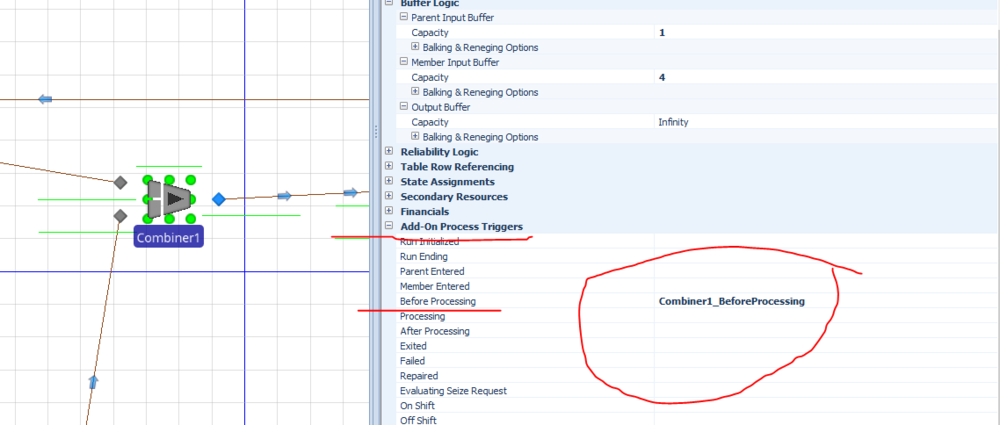Search the Community
Showing results for 'processing contents'.
-

Store Entities During Processing (Combiners in Series)
MEagar replied to Mike@CFAN's topic in SI General Discussions
Oh so you need to use an add on process to set the memberinputbuffer to zero, once a parent entity has entered the processing station. Remember to re-assign the capacity to 4 once processing has completed. As you are using paths, it would be good to set there capacity to 0 and 1 during the same process as to keep the member entities in the output buffer. Hope this helps. -
This is my first post on Simio forums so please let me know if this is the incorrect place. I have Default (Parent) entities that must go through only one series of combiners for processing the members (ModelEntity 1,2,3) that get attached. At the end of the series, a separator removes all members and the parent entity circles back to the start to acquire new members. No parent entity can start processing in the combiner series while another entity is going through that combiner series. I cannot figure out how to stop entities from entering the first combiner in a series while there is another entity processing in the same series. Ideally I would like to store these parent entities at a location until a series of combiners are free for processing. CombinersInSeries.spfx
-
Cant open your model... use a monitor element and set the condition to i.e. 75% of processing time...catch the process and seize the required resources with a move the objects...be sure to reserve the resources (block) upon arrival.... You will need to take your resources assignments out of the task sequences as currently defined. I am online today if you want me to have a look.
-
Dear All, New to Simio and struggling with the following problem. I would like to model an entity to exit a server at its assigned time as a state variable for now, I know this: Every entity is assigned before exiting the source with a state variable (pick-up time): TimeNow + random value between 1 -5 I want to use this state variable to decide with an add-on process if the server can finish processing; TimeNow == pick-up time if not, the server keeps processing. In other words, the processing time of the server depends on the state variable of each individual entity. Hope someone has tips or tricks to solve this!
-
I'm trying to model airport ground operations using workers for the different processes, servers for the gates, entities for arriving airplanes and TransferNodes to control the flow of entities and workers. My research is focused on the control of these ground processes, but I can't get my process logic correct.. I attached a simple model to help answering the question. I want the workers to move to the right server before the entity arrives there and can immediately start processing the entities. One method is to use a global queue from which workers decide which entity to process next based on some criteria and dynamic rule selection. In the attached model I use two entities which go to Gate1 and Gate2. Gate 1 needs workers move to the node before it can start processing, Gate 2 does not. Using an add-on process, I move the worker to the gate before it is requested and wait for the entity to arrive. But for some reason it does not start processing immediately when the entity arrives and I can't figure out how to model this correctly.. It's the first time I'm using Simio, so I some help would be appreciated on how to set up the logic for my processes.. I'm kinda stuck now on how to get some basics thing in my model right or if I'm using the right processes steps.. Thanks in advance! TestModelWorkers.spfx
-
How to choose between resource when there are conditions.
gocken replied to htatton's topic in SI General Discussions
First define an object list, then populate this list with the resource objects (or workers?). Order them accordinly (If you prefer grinder resource first one to utilize then the order should be grinder, welding. Then, under "secondary resources" category of server object expand "resource for processing" section and set "object type" as "select from list" and "object list name" property as "objectlist1". By this way the server object will try to seize grinder resource first. If it is not available it will try welding object. Still, If I were you I prefer to use task sequences option as dave suggested. -
Simio conveyors do not currently support discretely modeling two or more entities side by side. That feature has been proposed and designed, but it not yet scheduled for development (just a priority thing). One choice is to use the Flow constructs to model it as some combination of discrete and continuous. Another possible approach is to Combine discrete entities together or to have a single entity represent 2 or more entities - perhaps use a Separator when you need discrete processing. Yes, there is extensive information available about each entity (see screen shot from Watch window below). You can write this data to a file using the Write or ExcelWrite step.
- 1 reply
-
- conveyor belt
- parallel entities
-
(and 1 more)
Tagged with:
-
Let vehicle dwell only if loading or unloading an entity
gocken replied to Student789's topic in SI General Discussions
Vehicle.RideStation.Contents.NumberWaiting>1 -
Hello. I'm quite new to make process logic in Simio. I have 3 Servers(server1, server2, server3) and the entity travel from server1 to server2 and server3 in order by Vehicle1. The server2 and server3 do not have any buffer; zero input buffer and zero output buffer. So, I need a process which controls deadlock. I thought when the destination of Vehicle1 is Output@Server1, check whether server2 has an entity in processing buffer. If it has, again, check server3 has an entity in processing buffer. So, my conditions are below when the destination of Vehicle1 is Output@Server1. 1. If Server2 and Server3 have an entity in processing buffer, wait until Server3 has finished process, then transfer entity in server3 to Sink1 first and transfer entity in Server2 to Server3. 2. If Only Server2 has an entity, wait unitl Server2 has finished process, then transfer entity in Server2 to Server3 and transfer entity in Server1 to Server2. 3. If Only Server3 has an entity, do not wait any situation. I've built a process steps to implement it, but doesn't work.. I don't know my logic has problems or process step has problems... I've attached my model below. Could you solve or suggest about my problem? Thank you. Jay. RoutingProblem.spfx
-
I think "TheCombinersName.MemberInputBuffer.Contents.AverageTimeWaiting" is the expression you are looking for. -Adam
-
I'm new to Simio. I'm trying to split my original entity into two different parts. The goal is to have the entity be separated, with half of them having a different server processing times through the same server.
-
Hi, I am trying to create a simple model containing a source server and sink, where two parts travel throughout the system. However, I am trying to create by own dispatch logic to determine which part in the Server's input queue is chosen next. I am hoping to create a function f(x) = C1X1 + C2X2 where C1 and C2 are constants, X1 is the time the part has been in the queue, and X2 is the part type. The part which returns the highest value then proceeds to processing next. Is this possible to model, or can anyone point me in the right direction? Thanks in advance!
-

Telling Server not to process a specfic entity
MEagar replied to Hannan's topic in SI General Discussions
Using a conditional Math.If(Condition, True, False) which sets the processing time to 0 if the specific condition has been met may be of use. -
Interrupt server while Process Type is Task Sequence
FloraPhyll replied to FloraPhyll's topic in SI General Discussions
Dear Jeff, I've used the Task sequence directly in the property Processing time of the server. Maybe the reason why the interruption does not function. I'll try your approach by adding the tasks rather from the Definitions windows and see if it works. Thank you for your help ! Flora- 2 replies
-
- interrupt server
- process type
-
(and 1 more)
Tagged with:
-
Interrupt server while Process Type is Task Sequence
jzhou replied to FloraPhyll's topic in SI General Discussions
Dear Flora, I build a sample model to interrupt a task and afterwards resume that task with the remaining processing time pls kindly find the attched model. thanks! I am not quite understanding your approach, however the error you mentioned is the token is not targeting at Worker, thus the error... InterruptingTaskExample_byJeff2.spfx- 2 replies
-
- interrupt server
- process type
-
(and 1 more)
Tagged with:
-
Hi all, in my model I have a specific transfer node where a worker transfers an entity to a vehicle. I cant add the load unloading times in the worker or vehicle due to the fact that there is only loading time in this transfer point exactly. I was wondering if there is a way to directly add a "processing time" to this transfer point. Maybe by creating a subclass? Thanks
-
While I think all approaches mentioned above are good depending on the situation, I'll mention one more advanced approach, perhaps just for the educational value. While most people think of balking and reneging as a Server-type of option, it is actually implemented as a feature on every Station. So another approach, particularly if you encountered this situation a lot, might be to subclass the Server and change the properties of the Processing station to implement reneging on that station.
-
Thanks for the help. I came up with another solution, let me know what you think: The Entity has reached end of queue and is about to begin processing. In Server-Before Processing state assignments I recalculate .TimeTillDeath. At this time I will also give them a .TreatmentTime = random.exp(x). Actual server processing time is Min(ModelEntity.TimeTIllDeath, ModelEntity.TreatmentTime) Once they leave the station, my routing is based on if TimeTillDeath < Treatment Time. If that is true, then they had effectively died at end of service and are sent to a sink. I can see how this would fudge some of the Server stats in the results page, but I am not concerned about actual treatment times there. Let me know if i'm missing something.
-
Testing if resource is seized before releasing it
PierreUL replied to PierreUL's topic in SI General Discussions
With a decide step just before the release step in my process logic, I was able to test if the worker is seized. The condition I used is : ServerName.Processing.Contents.FirstItem.SeizedResources.Contains(WorkerName[1]). So thanks a lot! It's exactly what I needed! -

Testing if resource is seized before releasing it
MEagar replied to PierreUL's topic in SI General Discussions
Remembering that the entity in the processing station is the Owner of the Resources i.e. the server; and all three workers, if you place a watch on the entity and drill into "functions" of the entity in the watch window, you will find the variables for your conditional logic which you seek (see attached). Server.Processing.Contents.FirstItem.ModelEntity.SeizedResources.xxxx should suffice.... -
Hi everybody! I have a server where 3 workers or less are seized at te same time to complete the processing. In the "After_processing" process logic I would like to verify if a resource is indeed seized or not before to try to release it. I tried to use State variables which I give specific values at some strategical steps but I still have failures that occurs once in a while. I have no clue on how to do else. Could someone help me to find a "clean"way to do it ? Thank's in advance! Pierre
-
Dear all, I do have a table called machineProperties which describes properties of machines: Machine | ProcessingTime | ... machine1 | 2 |... machine2 | 1.5 | ... In my model I would like to assign the property "Processing time" to machineProperties(DisplayName;"ProcessingTime"). I guess Lookup tables might be working, but unfortunately I do not know how to link them to an Excel file. Does anyone know how to do this? Thank you! Best regards, Stefan
-
You could create multiple entity types through a single Source by using data tables and product mix- see the SimBit titled EntityFollowsSequenceWithTable.spfx. This would create entities based on the product mix specified in the JobTable data table. To create multiple of a specific type (man/woman) entering at a single time in a source, you could just simply create one type (man) and then use add-on process logic and a Create step to create the other type (woman) and have them continue processing.
-
Hello every body, I try to model a 3 servers process and I'm getting some trouble. The model is composed of 3 servers and 3 operators . Each operator is a "specialist" for a server, Worker 1, 2, 3 for the server 1, 2, 3 respectively. However the workers 2 and 3 can help the worker 1 at the server 1 if they are not busy. The processing time of server 1 will adjust proportionally to the number of workers working at the server. (There is a 4th worker whose task is to move parts to the server 3 or the sink. But I don't think it plays any role in the problem.) I've implemented some processes so that workers work at the right server. It was working perfectly. But then, as I modified the model to add the variable processing time, the Interrupt steps in the processes don't work anymore. Indeed, the worker 2 or 3 stay at the server 2 or 3 and don't go to help the worker 1 when servers 2 or 3 are blocked, or idle. As well, if workers 2 or 3 are busy at server 1 they are not interrupted when a part arrive to the server 2 or 3. I hope I'm clear enough. I've enclosed the model so that you can better picture the problem. Thank you for your attention and thank you in advance for any help I may get! three_workers_Interrupt.spfx
-
As far as I understand I included my solution approach. You may wonder that the included logic does not seem work (it will always increases the capacity but wont decrease it). This may be due to your servers processing time or on/off shift schedules. I mean that in order to see how it works you should increase capacity by some predeterimed number (i.e., 10. Currently it is set to 1) and decrease it one each time any entity enters or departs waitingarea1 node. you may also increase run time to further see what happens. I hope this one meets your requirements. Still it will inspire you. NOTE: You should note that the unit time conversions and your problems' values. The logic triggers capacity increments or decrements each time an entity enters or departs from waitingarea1. Note also that waiting times are calculated as averages of those who wait at waitingarea1 transfer node throughout the simulation run. pharmacy_candidate solution.spfx






